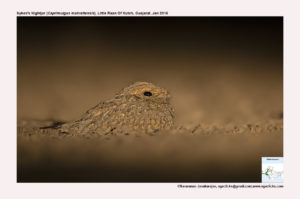
Syke’s Nightjar Caprimulgus mahrattensis
Etymology:
- Caprimulgus : Latin word capra – goat; mulgere –to milk . The nightjar were assumed to drink goats milk and injure the goats
- Mahrattensis: From the Maratha country in Deccan, India
Vernacular Names: Baluchistan: Shapkor, Guj: Retal-chhapo, Ran dasharadhiyu, Mar: Sykes Ratwa
Distribution in India: Breeds in North West of India. Winter visitor in central and south India.
Description: Size of 22-23 cm; wt. of male 58 g, female 56 g. They are sexually dimorphic, though not greatly so. The upperparts sandy-grey, lightly spotted blackish brown, with indistinct buffish nuchal collar; wing-coverts sandy-grey, streaked and vermiculated blackish brown and boldly spotted buff and pale buff, no scapular pattern; whitish submoustachial stripe and white throat patch; underparts sandy-grey spotted buff, barred brown, becoming buff barred brown on belly and flanks. Both sexes have large white spot on three outermost primaries, in female smaller and sometimes washed with buff; male has broad white tips to two outermost tail feathers, female having buffish-white tips. Iris is dark brown, bill is dark brown, legs and feet arepale fleshy-brown.The juvenile is paler and plainer than adult.
Habitat: It is found in semi-deserts with scattered thorn scrub; also dry stony scrubland, gravel or clay plains, flat salty ground with tamarisks, and stony wasteland; from sea-level to500 m.
Food Habits: It eats moths, helipterums, flying ants, grasshoppers, locusts, cockroaches, small wasps, termites and other insects. It is most active, and mostly feeds, near dawn and dusk (crepuscular – active during the twilight). At dusk, it often flies around livestock to feed on insects swarming around the animals. At night,it likes to take advantage of insects swarming around street lamps or other artificial light sources. It keeps their bills wide open as it flies through clouds of small insects. It may also forage under the canopy by flying from favored perches catching insects at foliage. Larger insects are usually taken back to their favored feeding perches. While holding the insects in their bills, It keeps the head upright, shake and swallow the prey whole, or they may break the insects apart before eating. Insects may also be taken from the ground or foliage.
Breeding Habits: They breed in March-July in India.The nest-site is in full sunlight, or sheltered beneath clump of grass or small bush; if no nest, eggs laid on bare, stony or salt-encrusted ground. They lay a clutch of 2 eggs . The incubation period is 17-18 days, commenced with last egg done by female alone. The male taking turns close to dusk and dawn.The chicks are born semi-precocial. The brooding bird, covering them closely with its camouflage plumage, is their best protection. The chicks can crawl away from the nest soon after hatching and hide among leaves when alarmed.